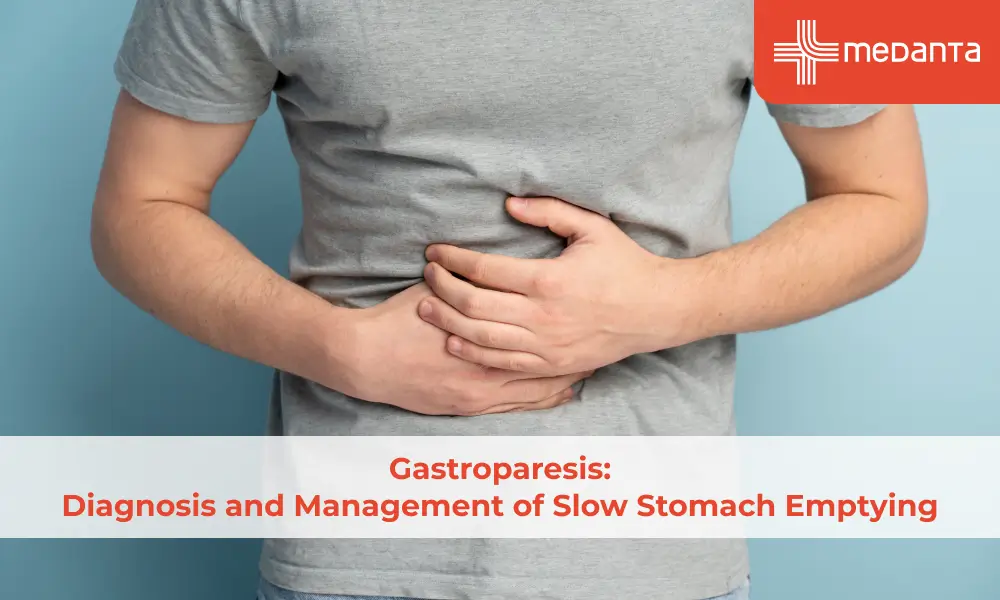THE EXCHANGE | Newsletter June 2022

Medanta Treats Patient with Rare Disease, Neuromyelitis Optica, Mimicking Acute Stroke
Neuromyelitis Optica Spectrum Disorder (NMOSD) is a rare autoimmune disease of the central nervous system (CNS) that primarily attacks the optic nerves, the brain and the spinal cord. It causes severe demyelination with typical clinical manifestation in the form of acute optic neuritis, longitudinally extensive transverse myelitis, diencephalic syndrome and area postrema syndrome. NMOSD is different from multiple sclerosis and is associated with serum aquaporin-4 antibodies (AQP4-IgG). Complement-dependent cytotoxicity, antibody-dependent cell cytotoxicity and cellular infiltration contribute to astrocyte destruction, oligodendrocyte injury and demyelination. A fourth of all NMOSD patients have coexisting autoimmune disease and about half have other autoantibodies. About 70%-80% patients with NMOSD produce autoantibodies to AQP4.
Case Study
A 46-year-old man, non-diabetic and non-hypertensive, was presented in the ER at Medanta - Ranchi with sudden onset of left-sided hemiparesis with vertigo, nausea and recurrent hiccups since the past one day. There was no history of diminution of vision or bladder involvement, fever, headache, seizure episode or loss of consciousness. A neurological examination revealed that the power in his left upper limb was 1/5 and that in the left lower limb was 3/5, while the power in the right upper limb and lower limb was 5/5. Other neurological examinations, including fundus examination, were found to be normal except subtle facial asymmetry. Since the onset was sudden, it was suggestive of posterior circulation stroke being the most likely possibility. Other possibilities considered were inflammatory or demyelinating disorders. Further investigations, such as MRI of the brain, revealed T2 and Fluid Attenuated Inversion Recovery (FLAIR) hyperintensity involving lower medulla with subtle post contrast enhancement. A screening MRI of the entire spine showed long segment myelitis extending from cervicomedullary junction to C7 vertebral level. Diagnostic lumbar puncture was also performed for cerebrospinal fluid (CSF) analysis. It showed mild lymphocytic pleocytosis (cell count=30/mm) with mildly elevated protein (88mg/dl). Serum for ANA, ANA-Profile, MOG (Myelin oligodendrocyte glycoprotein) antibody and aquaporin-4 antibody was sent along with CSF for screening of oligoclonal bands (OCB). Aquaporin-4 antibodies came out positive in serum test along with OCB in CSF. ANA, ANA profile and MOG antibody were negative. Based on image findings and lab reports, the patient was diagnosed with NMOSD. Hence, he was treated with Pulse IV methylprednisolone and advised 1g dose once a day for five days. On day three of therapy, the patient started to experience improvement in limb power and at the end of day five, the power in his left upper limb and lower limb had improved to 2/5 and 4/5, respectively. As the patient showed only partial improvement with Pulse IV methylprednisolone, options of IVIG and plasmapheresis were discussed with the patient’s family who expressed financial concerns. Hence, the patient was put on oral prednisolone and mycophenolate. He showed gradual neurological improvement, and was discharged from the hospital on the tenth day with significant improvement in his left limb power which had improved to 4/5 in the upper limb and lower limb, both.
The patient’s condition is stable, and he will be followed up closely in the OPD.
Dr Kumar Vijay Anand
Associate Consultant - Neurology
Institute of Neurosciences,
Medanta - Ranchi
In Focus
Abernethy Malformation Masquerading as Congenital Heart Disease: A Boy with Cyanosis, Clubbing and Hypoxia
Abernethy malformation is an extrahepatic congenital portosystemic shunt (CPSS), an extremely rare condition characterised by diversion of portal blood away from the liver. In this anomaly, blood from splanchnic circulation drains into the inferior vena cava (IVC) through a shunt bypassing the liver, thereby causing an alteration in metabolism of pulmonary vasoactive substances resulting in pulmonary vasodilation, diffusion-perfusion mismatch, and eventually hypoxemia. The clinical manifestations of Abernethy malformation are highly variable, and depend on the shunting of blood. Manifestation can be asymptomatic or symptomatic, which can include hepatic encephalopathy or hepatopulmonary syndrome (HPS). Abernethy malformation can be classified into two types.
Type I is defined by an absence of intrahepatic portal veins, and lack of liver perfusion with portal blood. In Type I(a), superior mesenteric and splenic veins drain separately into the IVC. In Type I(b), splanchnic blood drains via common trunk into IVC. Type II is defined by side-to-side anastomosis of the portal vein with IVC in which hypoplastic intrahepatic portal vein supplies some degree of portal flow to the liver parenchyma. Prolonged untreated severe hypoxemia can result in irreversible changes in pulmonary vasculature, and its consequences become incapacitating for the patient. Early shunt closure resolves hypoxemia and clinical symptomatology.
Case Study
A 9-year-old boy, 112 cm (<3rd centile) tall and weighing 19 kg (<3rd centile) presented in Medanta - Lucknow with cyanosis, clubbing, dyspnoea, and restricted growth since four years of age. Physical examination on admission revealed central cyanosis and digital clubbing with resting pulse oximetry (SpO2) of 60% on room air. Blood investigations showed elevated haemoglobin level of 15.5 g/L (normal range 11.5-15 g/L), a normal liver enzyme profile with aspartate aminotransferase (AST) 32 U/L (normal range 17-59 U/L), alanine aminotransferase (ALT) 19 U/L (normal range 21-72 U/L). He had elevated serum ammonia level of 77 μmol/L (normal range 7-30 μmol/L), but no evidence of hepatic encephalopathy was found. His coagulation profile was normal with an international normalised ratio of 1.39, and activated partial thromboplastin time (aPTT) of 30 s (normal range 24.6-29.9 s).
Chest X-ray showed mild cardiomegaly with increased pulmonary vascular markings. The ECG was unremarkable. Echocardiography revealed features of mild left-sided volume overload and dilated left atrium. A contrast echocardiography with agitated saline showed the appearance of micro-bubbles in the left atrium after four cardiac cycles, suggestive of pulmonary arteriovenous communication.
Doppler ultrasound showed dilated extrahepatic main PV with hypoplastic intrahepatic portal venous branches arising from the dilated segment and a large communicating shunt between the IVC and the main portal vein. Computed tomography (CT) angiography confirmed Type-II Abernethy malformation.
Hepatic veins were normal on Doppler and CT angiography.
Interventional Management
The patient was taken under general anaesthesia for endovascular management of the CPSS closure. Jugular and femoral access was taken, and the shunt was cannulated from both sides. Multiple
catheter angiograms were taken to establish the patency of the intrahepatic portal venous branches. After documenting the patency of intrahepatic portal venous branches, decision was taken to close the shunt. Angiogram showed the shunt diameter at 12 mm and length at 7 mm.
It was decided to close the shunt with a vascular plug closure device.The device was deployed across the shunt via the femoral route and angiograms taken from the jugular route, which gave visualisation of the intrahepatic portal branches for immediate closure of the shunt.
Discussion
In the presence of cyanosis and clubbing, clinicians usually suspect congenital heart disease until proven otherwise. However, there are uncommon conditions such as hemoglobinopathy, Abernethy malformation and diffuse pulmonary arteriovenous fistula resulting in cyanosis. As most of these patients end up in cardiothoracic surgery or cardiology clinics, detailed work up should be done and special attention should be paid to children with unexplained cyanosis where cardiac causes have been ruled out.
The case of the 9-year-old boy was also misdiagnosed, mistaken, and managed as cyanotic heart disease for many years before coming to Medanta-Lucknow. In resource-poor settings, the diagnosis of CPSS can be missed or delayed. However, with advanced imaging techniques available these days, the condition can be picked up easily. Diagnosis is also delayed and difficult due to varied clinical presentations. These patients typically reach the healthcare facility only when complications set in. Abernethy malformation may lead to severe complications such as liver tumours, hepatic encephalopathy, pulmonary hypertension, or HPS. The latter is a triad of liver diseases, arterial hypoxemia, and pulmonary vascular dilatation, and has been reported in at least 20 children with Abernethy malformation. Although HPS typically develops in the setting of cirrhosis and portal hypertension, it may also occur in the absence of parenchymal liver disease in association with portosystemic shunting. It is believed to be attributed to the exposure of the pulmonary vascular bed to vasoactive mediators derived from the intestinal tract entering the systemic circulation without being metabolised in the liver. Prolonged untreated cases result in pulmonary vasodilatation, pulmonary arteriovenous fistula, diffusion-perfusion mismatch, and eventually hypoxemia.
In this case, device closure of the shunt was successful. The patient’s serum ammonia levels normalised over a month’s time and hypoxemia corrected over a six-month period. At the one-year follow-up, his growth and exercise tolerance had improved, and resting oxygen saturation had increased from 60% to 92% on room air. CT angiography of the abdomen showed good hepatic portal circulation and there was no obstruction or misplacement of the device. No complication was noted.
Early diagnosis and appropriate management of Abernethy malformation may lead to improved prognosis.
Dr Abhai Verma
Director - Gastroenterology
Institute of Digestive and Hepatobiliary Sciences,
Medanta - Lucknow
Dr Durga Prasad
Consultant - Paediatric Gastroenterology
Institute of Digestive and Hepatobiliary Sciences,
Medanta - Lucknow
TechByte
Posterior Component Separation with Transversus Abdominis Release
Latest Technique to Treat Complex Hernias
A 62-year-old man presented at Medanta - Gurugram with a large incisional hernia after undergoing a hemicolectomy for right colon cancer three years ago. The hernia was increasing in size and affecting his quality of life. He had stopped his routine morning walk and even faced difficulty with bowel movement as the large hernia with loss of abdominal domain impacted his physiological functions.
After his colon cancer surgery, he had undergone adjuvant chemotherapy basis the biopsy score, which was T3 N1 M0. He also had a history of chronic obstructive pulmonary disease (COPD) but had stopped smoking after the cancer diagnosis.
The patient was evaluated with the help of PET/CT scan that showed a large 12x9 cm midline incisional hernia with suggestion of extensive adhesions within the hernia sac. A colonoscopy was also attempted, but it could not be completed because of extensive
looping of the endoscope within the hernia sac. There was no evidence of any recurrence of colon cancer.
A pulmonologist’s opinion was taken for preoperative optimisation. The patient underwent a posterior component separation surgery - transverse abdominis muscle release (TAR) combined with peritoneal flap hernioplasty. The technique utilises the peritoneal flap with a mesh sandwich technique. As transversus abdominis release is done, it enables placement of a very wide mesh to reinforce the entire visceral sac. The peritoneal flap is divided at midline, the left is attached to posterior sheath on one side and anterior sheath on the other side with a tension-free
closure. The five-hour-long surgery was uneventful, and the patient could be extubated immediately without any signs of abdominal compartment syndrome.
He was discharged on day five after the surgery. A year-and-a-half after the surgery, the patient is doing well. He has no signs of hernia recurrence or any other complication. He now walks 5-6 kilometres every day and his overall quality of life has improved.
Dr Vikas Singhal
Senior Consultant - GI Surgery, GI Oncology and Bariatric Surgery
Institute of Digestive and Hepatobiliary Sciences,
Medanta - Gurugram
Doctors Onboard
Dr Arulalan. M
Consultant, ENT, Neuro-otology and Skull Base Surgery, Lucknow
ENT and Head Neck Surgeon with extensive experience in the field of Otology, Neurotology and skull base surgery.
His expertise includes complex ear surgery, cochlear implantation, hearing loss treatment, balance disorders, facial nerve paralysis, and lateral and anterior skull base surgery.
Dr Harshvardhan Atreya
Director, Medical and Haemato Oncology, Lucknow
Medical and Haemato Oncologist with expertise in all types of solid tumour chemotherapies, intensive protocols, immunotherapies and hormonal therapies. He is an advanced bone marrow transplantation specialist and preventive care expert.
Dr Anil Gupta
Consultant, Paediatric Intensive Care, Lucknow
Paediatrician with extensive experience in treating critically sick children. He specialises in treating serious medical conditions and post-operative care for paediatric surgeries and organ transplant.
Dr Prerna Khurana
Consultant, Laboratory Medicine, Pathology and Blood Bank, Gurugram
Pathologist with expertise in antimicrobial stewardship, appropriate antibiotic usage and de-escalation of antibiotics, management of infectious diseases.
Dr Rana Chanchal
Consultant, Neonatology, Lucknow
Neonatologist with expertise in managing high-risk neonatal, perinatal and paediatric cases. He specialises in the care of sick neonates, newborns with low birth weight, premature babies, babies with sepsis requiring level-3 neonatal care, and cooling of neonates with perinatal asphyxia.
Dr Neeraj Kumar
Consultant, Institute of Musculoskeletal Disorders and Orthopaedics, Patna
Orthopaedic surgeon with expertise in complex periarticular surgeries, arthroplasty surgery of the hip and knee joint, knee arthroscopy surgeries for ACL, PCL and multi-ligament knee injury and deformity correction surgeries.
Dr Ankush Singh
Consultant, Institute of Neurosciences, Gurugram
Neurologist with extensive experience in treating leukodystrophies, demyelinating disorders, epileptic encephalopathies, cerebral palsy and neuromuscular disorder.






